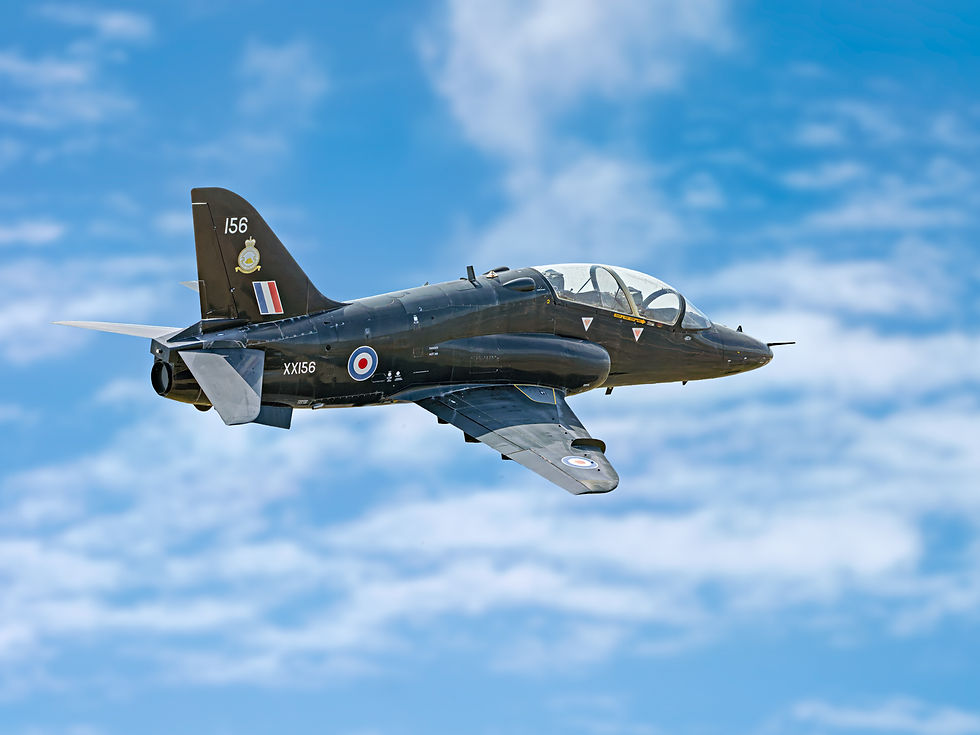RAF Valley
- Les Pickstock

- Jul 25
- 3 min read
Updated: Jul 27
Until the early 2000’s RAF Valley hosted airshows. As directly hosted by the RAF – similar to those at Cosford – these were quite spectacular, with many international air forces represented. As Valley has longer runways than Cosford, it handled a much greater variety of planes both in the air and on the ground. However, many photographers, interested in aircraft photography, do not think about Valley these days as a particularly good venue. But it can be.
Easy to reach, it is a few miles off the A55 on Anglesey, Post Code LL65 3NY for the northern viewing area (a hundred yards over the railway bridge, tun right into the viewing area NOT left into the guarded airfield) or an alternate one at the other end of the runway Post Code LL64 5QX, just outside Rhosneigr, close to the railway station, adjacent to the golf club. Both have easy/free parking. Which to choose is determined by the wind direction - aircraft take off and land into the wind.

RAF Valley is a Royal Air Force station on the island of Anglesey, Wales, and which is also used (occasionally) as the commercial Anglesey Airport. It provides both basic flying and advanced fast-jet training using the Beechcraft Texan T1 and BAE Systems Hawk T2, and provides mountain and maritime training for aircrew using the Airbus Jupiter HT1 helicopter - a twin-engine craft used for advanced rotary wing training, with digital technology and enhanced safety.

Almost all Hawks, Texans and HT1s that use either the Mach Loop or the Lake District for low-level training are based at Valley.

Predominantly the site offers take off/landing views of the two main training planes. Though as a ‘full size’ military airfield it can and does handle others, such as the Eurofighter Typhoon and the larger transports, including the A400. The main advantage of Valley, as a training airfield, is the numerous take offs and landings every day (though not at weekends or really bad weather).

Another plus is you probably will get all combination of aircraft and angles (thence variant photographs) within 2-3 hours, leaving time to visit other Anglesey locations, such as South Stack, Trac Mon racing circuit or the Dingle at Llangefni (Red Squirrels). A favourite alternative location is Cemlyn Bay for the Turns (May to July). Anglesey is quite small – about 20 x 17 miles – facilitating visiting many locations in one day.

One big problem with runway-based aircraft photography is ‘heat haze’, both atmospheric (runways naturally attract heat even in cool weather) and that created by the aircraft themselves. There is no practical way of either avoiding this or correcting. Many photographers ‘emphasise’ the haze, giving the aircraft an ‘ethereal glow’. Where aircraft take off away from you – especially with jets – within a few seconds there is just a thick haze caused by the exhaust – not a pretty picture.

For those more interested in feathered flying things, just before reaching the Valley northern viewing area there is a small RSPB ‘wetlands’ reserve at RSPB Valley Wetlands, Holyhead LL65 3NA. RSPB Cors Ddyga, just a few miles away at LL60 6LB, lies within one of the largest lowland wetlands in Wales. There are a number of ‘small’ RSPB sites on Anglesey. Usually without any ‘facilities’ – just limited parking.

There are no nearby ‘bacon butty cafes’ that I have found, but you can go into Rhosneigr where there are many cafes and bars. If you settle for ‘fish and chips’, double-check they use Anglesey Sea Salt - hand-harvested, organic-approved Welsh sea salt made from Anglesey Sea Water and nothing else. It makes a real difference to the taste!




Excellent insight Les, to the places to go on Anglesey, especially if you are an aircraft enthusiast
Thanks Les, an interesting take on a resourse right on our doorstep.